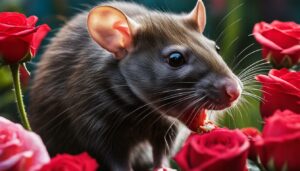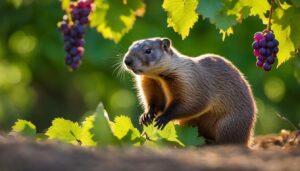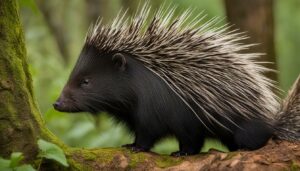Georgia’s diverse wildlife includes a variety of native animals, but are porcupines among them? While sightings of porcupines in the Southern states, including Georgia, are scarce, these fascinating creatures can indeed be found in the state, particularly in mountainous and hilly regions.
Porcupines are native to the United States and are commonly found in Eastern states such as Vermont, New Hampshire, and Maine. Although they may not be as prevalent in Georgia as in these states, porcupines can often be spotted in wooded areas throughout the state.
As herbivores, porcupines have a diet that consists of fruits, nuts, bark, and leaves. They are generally shy and will try to avoid human contact unless they feel threatened. Porcupines are known for their sharp quills, which they will release when they feel in danger. It is important to keep a safe distance and avoid direct contact with these quills.
In some areas, it is possible to keep a porcupine as a pet. However, it is crucial to familiarize yourself with the regulations in your specific location before considering the idea. Keeping a porcupine as a pet requires proper knowledge and understanding of their unique needs and behaviors.
Porcupines primarily feed on the bark of trees such as hemlock, birch, beech, pine, aspen, elm, oak, willow, spruce, and fir. They also consume wildflowers, acorns, roots, and seeds as part of their diet.
Key Takeaways:
- Porcupines can be found in Georgia, particularly in mountainous and hilly regions.
- They are native to the United States and often seen in Eastern states.
- Porcupines are herbivores, consuming fruits, nuts, bark, and leaves.
- They are generally timid creatures and will try to avoid humans unless they feel threatened.
- Porcupines have sharp quills on their backs, which they release when threatened.
Porcupines in Georgia: Distribution and Habitat
Porcupines can indeed be found in Georgia, but their distribution and habitat are more specific. These unique creatures are native to the United States and can be found in various Eastern states, including Vermont, New Hampshire, and Maine. While porcupine sightings in Southern states like Georgia may be less common, they do inhabit the state and are often spotted in wooded areas, particularly in mountainous and hilly regions.
Porcupines are herbivores, feeding on a diet of fruits, nuts, bark, and leaves. They have a preference for the bark of trees such as hemlock, birch, beech, pine, aspen, elm, oak, willow, spruce, and fir. In addition to tree bark, they also consume wildflowers, acorns, roots, and seeds. These dietary preferences are important considerations when it comes to their habitat.
While porcupines may have a reputation for being prickly, they are generally timid creatures and will do their best to avoid human contact. However, if they feel threatened, they have a unique defense mechanism – sharp quills on their backs. When threatened, a porcupine will release its quills, making contact with them a painful experience. It is essential to maintain a safe distance and avoid touching or approaching porcupines to prevent any harm.
It is worth noting that some individuals may express an interest in keeping a porcupine as a pet. However, before considering this, it is important to check local regulations and licensing requirements. The appropriate authorities can provide guidance on whether it is legal to keep a porcupine as a pet in your area. Additionally, owning a porcupine as a pet requires specific knowledge and accommodations to ensure their safety and well-being.
| Porcupine Habitat in Georgia | |
|---|---|
| Common Locations: | Wooded areas, mountainous regions, hilly terrain |
| Preferred Trees: | Hemlock, birch, beech, pine, aspen, elm, oak, willow, spruce, fir |
| Diet: | Fruits, nuts, bark, leaves, wildflowers, acorns, roots, seeds |
Porcupines are fascinating creatures that exist within the wildlife of Georgia. While they are not as commonly seen as other animals in the state, their presence adds to the diversity of Georgia’s ecosystem. If you happen to venture into the wooded areas or mountainous regions, keep an eye out for these intriguing creatures, but always respect their space and avoid any unnecessary contact.
Porcupine Behavior and Characteristics
Porcupines in Georgia exhibit specific behavior and possess unique characteristics that set them apart from other native animals. These fascinating creatures are herbivores, relying on a diet of fruits, nuts, bark, and leaves. They can often be found in wooded areas, particularly in the state’s mountainous and hilly regions.
Despite their prickly appearance, porcupines are generally timid and will go to great lengths to avoid human interaction. They prefer to stay hidden during the day and are most active at night. If they feel threatened, porcupines will raise their quills as a defensive mechanism. These quills are sharp and barbed, designed to stick into an attacker upon contact. Therefore, it is important to avoid touching or provoking porcupines to prevent injury.
Porcupines play an important role in Georgia’s ecosystem. By consuming bark, they help manage tree populations and contribute to forest health. They also aid in seed dispersal as they move through the forest, helping to regenerate plant life. Although sightings of porcupines in Georgia may be rare, their presence is an important part of the state’s diverse animal species.
Porcupine Behavior and Characteristics
Porcupines in Georgia exhibit specific behavior and possess unique characteristics that set them apart from other native animals. These fascinating creatures are herbivores, relying on a diet of fruits, nuts, bark, and leaves. They can often be found in wooded areas, particularly in the state’s mountainous and hilly regions.
Despite their prickly appearance, porcupines are generally timid and will go to great lengths to avoid human interaction. They prefer to stay hidden during the day and are most active at night. If they feel threatened, porcupines will raise their quills as a defensive mechanism. These quills are sharp and barbed, designed to stick into an attacker upon contact. Therefore, it is important to avoid touching or provoking porcupines to prevent injury.
Porcupines play an important role in Georgia’s ecosystem. By consuming bark, they help manage tree populations and contribute to forest health. They also aid in seed dispersal as they move through the forest, helping to regenerate plant life. Although sightings of porcupines in Georgia may be rare, their presence is an important part of the state’s diverse animal species.
| Porcupine Behavior and Characteristics |
|---|
| Porcupines in Georgia exhibit specific behavior and possess unique characteristics that set them apart from other native animals. These fascinating creatures are herbivores, relying on a diet of fruits, nuts, bark, and leaves. They can often be found in wooded areas, particularly in the state’s mountainous and hilly regions. |
| Despite their prickly appearance, porcupines are generally timid and will go to great lengths to avoid human interaction. They prefer to stay hidden during the day and are most active at night. If they feel threatened, porcupines will raise their quills as a defensive mechanism. These quills are sharp and barbed, designed to stick into an attacker upon contact. Therefore, it is important to avoid touching or provoking porcupines to prevent injury. |
| Porcupines play an important role in Georgia’s ecosystem. By consuming bark, they help manage tree populations and contribute to forest health. They also aid in seed dispersal as they move through the forest, helping to regenerate plant life. Although sightings of porcupines in Georgia may be rare, their presence is an important part of the state’s diverse animal species. |
Porcupine Quills and Defense Mechanisms
Porcupines possess a formidable defense mechanism in their quills, making them an intriguing sight in Georgia’s wildlife. These quills are sharp, barbed hairs that cover their back, sides, and tail. When a porcupine feels threatened, it will raise its quills to make itself appear larger and more intimidating. If the threat persists, the porcupine will deliver a warning, shaking its body to create a rattling sound as the quills vibrate against each other. This is often enough to deter predators.
If an attacker does not heed the warning and persists in its approach, the porcupine will go on the offensive. It can lunge backward or sideways, impaling the attacker with its quills. These quills have a unique structure with microscopic barbs that make them difficult to remove. When they penetrate the skin, the barbs become embedded, causing pain and making it extremely challenging for a predator to dislodge the quills.
It’s important to note that the quills are not venomous, but they can lead to infection if not properly treated. Animals that prey on porcupines, such as coyotes or foxes, have learned to avoid attacking them altogether due to the painful consequences. Even large predators like bears and cougars have learned to give porcupines a wide berth, as a face full of quills can be a painful lesson.
| Porcupine Defense Mechanisms | Benefits |
|---|---|
| Quills | Deter predators with their sharpness and barbs. |
| Warning Rattle | Intimidates potential threats, signaling the porcupine’s readiness to defend itself. |
| Impaling | Delivers a painful lesson to predators who persist in attacking. |
While porcupines are known for their defensive quills, it’s important to remember that they are generally docile creatures and would rather avoid conflict. They spend most of their time in trees, where their slow movements and excellent climbing ability provide them with safety. So, if you ever encounter a porcupine in Georgia, appreciate its unique defense mechanisms from a safe distance and enjoy observing this fascinating creature in its natural habitat.
Spotting Porcupines in Georgia
While sightings of porcupines in Georgia may be rare, there are ways to increase your chances of spotting these intriguing creatures. Porcupines can typically be found in mountainous and hilly regions, particularly in wooded areas. If you’re an outdoor enthusiast or wildlife lover, exploring these habitats may offer you the opportunity to catch a glimpse of these unique animals.
Porcupines are primarily nocturnal, meaning they are most active during the nighttime. If you’re hoping to spot one, consider venturing into the wilderness during the early morning or late evening hours. This increases your chances of encountering a porcupine as they search for food and explore their surroundings.
When exploring wooded areas, keep an eye out for signs of porcupine activity. Look for chewed tree bark, especially near the base of trees. Porcupines are herbivores and enjoy feasting on the bark, leaves, and twigs of various trees, such as hemlock, birch, beech, pine, and oak. If you come across these telltale signs, it’s a good indication that porcupines are present in the area.
Spotting Porcupines in Georgia: Tips for Wildlife Enthusiasts
- Visit mountainous and hilly regions, particularly wooded areas.
- Explore during early morning or late evening hours, when porcupines are most active.
- Look for signs of porcupine activity, such as chewed tree bark and twigs.
- Be patient and quiet, as porcupines are generally shy and prefer to avoid human interaction.
- Remember to maintain a safe distance and avoid any direct contact with porcupines, as they possess sharp quills that they can release when threatened.
| Porcupine Diet | Preferred Vegetation |
|---|---|
| Herbivorous | Bark of trees: hemlock, birch, beech, pine, aspen, elm, oak, willow, spruce, fir |
| Wildflowers, acorns, roots, seeds |
Porcupine Threats and Conservation Efforts
Porcupines in Georgia, like many other wildlife species, face various threats, prompting conservation efforts to ensure their survival. The encroachment of human activities, such as deforestation and urbanization, has resulted in the loss of natural habitat for these creatures. As their forest homes are destroyed, porcupines are forced to adapt to new environments or seek refuge in isolated and fragmented areas. This habitat loss poses a significant challenge for their long-term survival.
In addition to habitat loss, porcupines also face threats from hunting and predation. Some individuals may view porcupines as pests and target them for eradication. Predators such as coyotes and bobcats may also pose a danger to porcupines, as they are not deterred by their quills and are skilled at hunting them. These combined threats have led to a decline in porcupine populations in some areas of Georgia.
To counteract these threats, conservation efforts are underway throughout the state. Organizations are working to protect and restore porcupine habitat, ensuring that there are suitable areas for these creatures to thrive. Reforestation initiatives aim to increase the availability of food sources and provide shelter for porcupines. Conservationists also promote education and awareness about the importance of preserving Georgia’s wildlife, including the porcupine population.
Conservation Efforts for Porcupines in Georgia
Efforts are being made to monitor and study porcupine populations in order to better understand their habits, behavior, and needs. This knowledge is crucial for implementing effective conservation strategies. By gathering data on porcupine distribution and population trends, scientists can identify areas of high conservation priority and develop targeted conservation plans.
| Conservation Measures | Benefits |
|---|---|
| Habitat protection and restoration | Ensures suitable habitats for porcupines to thrive |
| Reducing human-wildlife conflicts | Minimizes porcupine hunting and predation risks |
| Community education and awareness | Promotes understanding and appreciation for porcupines and their role in the ecosystem |
| Collaboration with landowners and stakeholders | Encourages shared responsibility for porcupine conservation |
Through these conservation efforts, it is hoped that porcupine populations in Georgia can rebound and thrive. By protecting their natural habitat, reducing human-wildlife conflicts, and raising awareness about their importance, we can contribute to the preservation of this unique species and ensure a harmonious coexistence between humans and porcupines in Georgia.
Can You Keep a Porcupine as a Pet in Georgia?
While porcupines may intrigue some individuals, it’s important to understand the regulations and factors involved in keeping them as pets in Georgia. Porcupines are native to the United States and can be found in Eastern states such as Vermont, New Hampshire, and Maine. While sightings of porcupines in the Southern states including Georgia are scarce, they do reside in the state and can often be spotted in wooded areas.
Porcupines are herbivores, consuming fruits, nuts, bark, and leaves. They primarily feed on the bark of trees such as hemlock, birch, beech, pine, aspen, elm, oak, willow, spruce, and fir, as well as wildflowers, acorns, roots, and seeds. However, before considering keeping a porcupine as a pet in Georgia, it is necessary to check the regulations in your area.
It’s important to note that porcupines have sharp quills on their backs and will release them when threatened. This defense mechanism can cause injury to humans or other animals. Therefore, proper care and handling techniques are crucial when keeping a porcupine as a pet. Additionally, porcupines require specific habitat and diet requirements to thrive, so it’s essential to ensure that you can provide a suitable environment for them.
As with any exotic pet, it is always recommended to consult with local authorities or wildlife experts to understand the legalities and responsibilities involved in owning a porcupine. They can provide guidance on the permits, licenses, and regulations required for keeping a porcupine as a pet in Georgia, ensuring the welfare of the animal and compliance with the law.
| Regulations | Factors to Consider |
|---|---|
| Check local regulations regarding pet ownership | Ensure you have the time and resources to properly care for a porcupine |
| Research specific laws and permits required in your area | Provide a suitable habitat with the necessary space and enrichment |
| Consult with wildlife experts for advice and guidance | Consider the potential risks associated with owning a porcupine |
Porcupine Diet and Feeding Habits
Porcupines in Georgia have specific dietary preferences, with certain trees and plants being their primary source of sustenance. These herbivores consume a variety of vegetation, including fruits, nuts, bark, and leaves. They are known to feed on the bark of trees such as hemlock, birch, beech, pine, aspen, elm, oak, willow, spruce, and fir. In addition to tree bark, porcupines also enjoy wildflowers, acorns, roots, and seeds. Their diet is well-suited to their environments, allowing them to adapt to different ecosystems.
Porcupines use their sharp, strong teeth to gnaw through tree bark and access the inner layers. This behavior helps them maintain their teeth, which continually grow throughout their lives. By consuming a variety of vegetation, porcupines ensure they receive the necessary nutrients to survive and thrive in their habitats.
While porcupines primarily rely on trees and plants for sustenance, they may venture into gardens or other human-populated areas in search of food. This can lead to conflicts with humans who may view porcupines as pests. However, it is important to remember that porcupines play a vital role in ecosystems by helping control vegetation growth and contributing to nutrient cycling.
| Vegetation | Main Food Source |
|---|---|
| Hemlock, birch, beech, pine, aspen, elm | Bark |
| Oak, willow, spruce, fir | Bark, leaves |
| Wildflowers, acorns, roots, seeds | Miscellaneous |
By understanding the dietary preferences of porcupines in Georgia, we can appreciate their ecological importance and coexist with these fascinating animals. It is crucial to respect their natural habitats and avoid any actions that may disturb or harm them.
Conclusion
Porcupines, though not commonly seen, are indeed present in Georgia, adding to the diversity of the state’s animal species. These fascinating creatures can be found in mountainous and hilly regions of the state, as well as in wooded areas. While sightings may be scarce, it is still possible to spot a porcupine in Georgia if you know where to look.
Porcupines are herbivores, deriving their diet from a variety of vegetation including fruits, nuts, bark, and leaves. They are generally shy and will avoid human contact whenever possible. However, if they feel threatened, they have a unique defense mechanism – sharp quills on their backs that they can release when necessary.
It is important to exercise caution and avoid direct contact with porcupines, as their quills can be painful if they become embedded in the skin. If you encounter a porcupine, it is best to observe from a safe distance and give them space.
While some may be fascinated by porcupines and consider keeping them as pets, it is important to check the regulations in your area before doing so. Porcupines require specialized care and environments to thrive, and it is crucial to ensure that you are able to provide for their specific needs.
FAQ
Are porcupines native to Georgia?
Yes, porcupines can be found in Georgia, particularly in mountainous and hilly regions.
Where else in the United States are porcupines found?
Porcupines are native to the United States and can be found in Eastern states such as Vermont, New Hampshire, and Maine.
How often are porcupines spotted in Georgia?
While sightings of porcupines in the Southern states including Georgia are scarce, they do reside in the state and can often be spotted in wooded areas.
What do porcupines eat?
Porcupines are herbivores and consume fruits, nuts, bark, and leaves. They primarily feed on the bark of trees such as hemlock, birch, beech, pine, aspen, elm, oak, willow, spruce, and fir, as well as wildflowers, acorns, roots, and seeds.
Are porcupines dangerous?
Porcupines are generally timid creatures and will try to avoid humans unless they feel threatened. They have sharp quills on their backs and will release them when threatened, so it is important to avoid contact with them.
Can porcupines be kept as pets in Georgia?
While porcupines can be kept as pets, it is necessary to check the regulations in your area before doing so.




